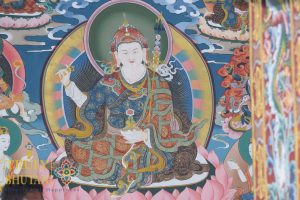Prehistory
Bhutan’s prehistoric(Bhutan History Timeline) era fell roughly between 500 B.C. and A.D. 500. Natural calamities and man-made activities like fire, earthquake, flood, and battles destroyed whatever records may once have existed. For instance, the fire accident in 1832 in a Dzong (monastery-fortress) in the old capital Punakha, and the major damages caused to the same structure by an earthquake in 1897 were the specific causes of destruction to Bhutan’s historical documentation of that era. Nevertheless, several stone tools and megaliths available suggest that Bhutan was populated as early as 2000-1500 B.C.
Also little is known about the country’s early history. The preserved artifacts available in some of the ancient monasteries indicated, that Bonism, a shamanistic ritual, was followed in Bhutan before the advent of Buddhism. The Bon tradition and ritual are still observed in some rural areas of Bhutan during the celebration of local festivals.

Early history
The country’s recorded history dates back to the era of the introduction of Buddhism in the 7th century A.D. Soon after, Buddhism greatly shaped the history of Bhutan and the tradition of its inhabitants. Bhutan’s physical location kept the ancient world at bay and together with the policy of self-imposed isolation this small kingdom was never colonized which is a matter of great pride to the Bhutanese. Its ancient history is a mixture of oral tradition and classical literature and tells of a largely self-sufficient population that had little contact with the outside world until 1900.
Two visible and treasured structures of ancient Bhutan are the Kyichu monastery in Paro and Jambay Lhakhang monastery in Bumthang which were built in the 7th Century A.D., a period when little was known about the land. However, only after the visit of a great Buddhist Saint Guru Rinpoche (Padmasambhava) in 747 A.D., did the foundation of Buddhism become strong in the country. Some of the most revered and sacred sites of pilgrimage related to the Guru still exist in Paro and Bumthang valleys; the places where he meditated, transformed the local demons and left the imprint of his body on a rock.
Medieval history
A subsequent remarkable chapter was added to the history of Bhutan, in the early part of the 13th century with the arrival of a Buddhist spiritual master, Phajo Drugom Zhingpo from Tibet. He was the precursor of the Kagyu institution of Mahayana Buddhism which eventually gained supremacy in the country to date. Over the years, several saints and religious figures helped shape Bhutan’s history and develop its religion. Among the influential figures, the Tertons (Treasure discoverers) played a crucial role with their pre-destined power to unearth the relics hidden for posterity by Guru Rinpoche and other saints.
The Terton Pema Lingpa occupies the most important place among treasure hunters in Bhutanese history for his discovery of relics from a lake called Mebartsho (The Burning Lake) in Bumthang. Apart from discovering religious texts and artifacts he also composed dances and created arts that have become one of the most important constituents of the cultural heritage of Bhutan.
The Zhabdrung (meaning the precious jewel at whose feet one submits) in the 17th Century opened the most dynamic era in the history of Bhutan.
The religious and secular powers were not delineated until then and Zhabdrung Ngawang Namgyal, the great leader of the Drukpa school of Mahayana Buddhism, established the dual system of government; the temporal and theocratic with Je Khenpo (chief abbot) as the religious head and the Desi as the temporal leader. In this system, a spiritual leader looked after the clergy while simultaneously a temporal ruler looked after the affairs of the state.
Besides proving himself a great spiritual personality and a statesman, he also left his permanent legacy as a great architect and builder. The Zhabdrung constructed numerous Dzongs (fortress), monasteries, and religious institutions bringing people of all levels under one faith and tightly establishing the Drukpa Kagyu as the state religion.
This dual system of governance introduced by the Zhabdrung was ruled by 54 Desis and 60 Je Khenpos and guided Bhutan from 1651 to 1907 until the foundation of the Wangchuck dynasty and the establishment of a hereditary Monarch a century ago.
Bhutan: A Comprehensive Timeline of its History from Antiquity to the Present
Bhutan, known as the “Land of the Thunder Dragon,” is a diminutive Himalayan country revered for its exceptional culture, awe-inspiring natural beauty, and extraordinary past. From its earliest settlement to contemporary times, Bhutan has undergone a plethora of changes, wars, and political transformations. In this article, we present an all-inclusive timeline of Bhutan’s history, starting from ancient times to the present day.
Bhutan’s history is enshrouded in a labyrinth of myths and legends, and its earliest settlers remain elusive. However, archaeological findings suggest that people have been dwelling in Bhutan for over four millennia. The country’s unique location and topography have made it an essential center for trade and commerce between India and Tibet, thereby exposing it to invasions and conflicts.
- Early Bhutanese History: The earliest records of Bhutan date back to the 9th century when Guru Rinpoche, or Padmasambhava, introduced Buddhism to the region. The 9th century also saw the rise of the Bon religion in Bhutan, which later merged with Buddhism.
- The Emergence of Drukpa Kagyu School: The 13th century witnessed the arrival of Phajo Drugom Zhigpo, who founded the Drukpa Kagyu School of Buddhism in Bhutan. This school emerged as the dominant sect of Buddhism in Bhutan and played a critical role in shaping the country’s culture and identity.
- Medieval Bhutan & The Emergence of the Drukpa Kagyu School: The 17th century was a significant era in Bhutan’s history as it marked the emergence of the Drukpa Kagyu School as a potent force in the region. This period also saw the arrival of Zhabdrung Ngawang Namgyal, who unified Bhutan and established a dual system of governance consisting of the spiritual leader, Je Khenpo, and the secular leader, the Druk Desi.
- Unification of Bhutan under Zhabdrung Ngawang Namgyal: In 1616, Zhabdrung Ngawang Namgyal came to Bhutan and started the process of unifying the country. He defeated several regional warlords and established a centralized government that lasted until the beginning of the 20th century. He also constructed several dzongs (fortresses) across Bhutan, which served as centers of governance, religious activity, and defence.
- British Influence & the Signing of the Treaty of Punakha: In the 19th century, Bhutan came under the sway of the British Empire, which aimed to establish a presence in the region to counter the influence of Russia and China. In 1865, the Treaty of Sinchula was signed between Bhutan and British India, which granted the British control over Bhutan’s foreign affairs. However, Bhutan retained its independence and continued to govern its internal affairs.
Modern Bhutan: The Reign of the Wangchuck Dynasty
In 1907, Ugyen Wangchuck was elected as the first hereditary king of Bhutan, heralding the beginning of the Wangchuck dynasty. The Wangchucks modernized Bhutan, abolished slavery, introduced a codified legal system, and established schools. They also maintained Bhutan’s unique cultural identity by preserving its customs, language, and religion. In 2008, the fifth king of Bhutan, Jigme Khesar Namgyel Wangchuck, abdicated the throne in favor of democracy, and the country transitioned into a democratic constitutional monarchy.
Bhutan’s Democratic Transition
In 2008, Bhutan conducted its first democratic elections, marking a significant shift in Bhutan’s political landscape. The country’s new constitution ensured fundamental rights, established a bicameral parliament, and vested executive powers in an elected prime minister while placing the king as the head of state. Bhutan’s peaceful transition to democracy has made the country an exemplar of democratic governance and human development.
Bhutan’s history is a testament to its unique culture, identity, and resilience. From its earliest settlement to the present day, Bhutan has undergone numerous changes and political transformations, but it has always maintained its independence, sovereignty, and cultural heritage. Bhutan’s transition to democracy and its unwavering commitment to Gross National Happiness have earned it a reputation as one of the happiest and most sustainable countries in the world.
Bhutan’s prehistoric era fell roughly between 500 B.C. and A.D. 500.
Bonism, a shamanistic ritual, was practiced in Bhutan before the advent of Buddhism.
The Kyichu monastery in Paro and Jambay monastery in Bumthang were built in the 7th Century A.D.
Phajo Drugom Zhingpo was the Buddhist spiritual master who arrived in the early 13th century and founded the Kagyu institution of Mahayana Buddhism in Bhutan.
The dual system of government established by Zhabdrung Ngawang Namgyal consisted of a spiritual leader, the Je Khenpo, as the religious head and the Desi as the temporal leader, with each looking after different aspects of governance.
